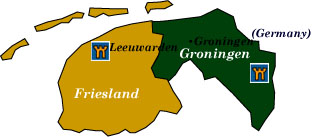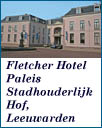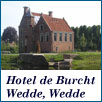Castle Hotels of Friesland and Groningen

![]() Fletcher Hotel Paleis Stadhouderlijk Hof
Fletcher Hotel Paleis Stadhouderlijk Hof
Haven’t decided on a hotel yet? You can look at other available hotels in Friesland and Groningen with Booking.com.
Even with its unique language and culture, Friesland has always lain in the shadow of the Netherlands other provinces. It wasn’t always like this. Before the arrival of Charlemagne, Frisian kings commanded the entire coast from Belgium to northern Germany. Visitors today come to enjoy sparsely populated countryside, lakes, and the West Frisian Islands—a UNESCO World Heritage Site.
Spend any time in Groningen and you’ll discover moated manor houses, fortified towns, castles, windmills, rural churches, and a university town filled with cafes and restaurants. At its heart, the province is peaceful and rural. If you see an area of elevated land, that’s a terp in front of you—a rise built by the inhabitants centuries ago for protection against rising sea levels. Over 1,200 terpen exist in Groningen and Friesland.
Go to a Different Region
Limburg and North Brabant
North Holland
South Holland and Zeeland
Utrecht and Gelderland
Some great reasons to visit
![]() Leeuwarden (Ljouwert) Picturesque canals and historic buildings mark the capital of Friesland. Before heading out into the countryside, take a little time and visit one of Leeuwarden’s fine museums:
Leeuwarden (Ljouwert) Picturesque canals and historic buildings mark the capital of Friesland. Before heading out into the countryside, take a little time and visit one of Leeuwarden’s fine museums:
Fries Museum is located in a 16th-century courthouse, an 18th-century patrician mansion, and a few other historical buildings. Its exhibits concentrate on the history of Friesland, including the Dutch resistance movement of World War II, and the story of the famous World War I spy and native daughter Mata Hari (just down the road from the museum and along the canal, you’ll find a statue of her). The museum also exhibits a superb collection of silver.
Princessehof Museum The Netherlands is known for its ceramics and tile work known as Delftware. An enormous collection of Dutch, Spanish, and Chinese tile work and porcelain is on display in a palace which was once the home of Maria Louise van Hessen-Kassel, mother of William IV.
Natuurmuseum Fryslân If traveling with children, they’ll enjoy the interactive displays. The most interesting exhibit here is “Friesland Underwater,” where you can view what the bottom of a canal looks like.
![]() Franeker (Frjentsjer) This charming small town is home to the 18th-century Eise Eisinga Planetarium, the oldest working planetarium in the world.
Franeker (Frjentsjer) This charming small town is home to the 18th-century Eise Eisinga Planetarium, the oldest working planetarium in the world.
![]() Hindeloopen (Hylpen) Wooden footbridges crossing over small canals and narrow lanes passing by charming houses make Hindeloopen one of the most delightful towns of Friesland. A former Hanseatic League trading port, today’s inhabitants have a distinct dialect and costume. Craftspeople specialize in hand-painted furniture. The Eerste Friese Schaatsmuseum (or First Frisian Skating Museum) is the place to come if you love skating. All the medals, photos, and skates on display will keep you busy. You will also find here an exhibition dedicated to the Elfstedentocht (Eleven Towns Race), a famous 200-km (125-mile) skating race that only occurs when the winter is very cold and the canal ice is thick enough.
Hindeloopen (Hylpen) Wooden footbridges crossing over small canals and narrow lanes passing by charming houses make Hindeloopen one of the most delightful towns of Friesland. A former Hanseatic League trading port, today’s inhabitants have a distinct dialect and costume. Craftspeople specialize in hand-painted furniture. The Eerste Friese Schaatsmuseum (or First Frisian Skating Museum) is the place to come if you love skating. All the medals, photos, and skates on display will keep you busy. You will also find here an exhibition dedicated to the Elfstedentocht (Eleven Towns Race), a famous 200-km (125-mile) skating race that only occurs when the winter is very cold and the canal ice is thick enough.
![]() Frisian Islands Across the Waddenzee (a UNESCO World Heritage Site), a string of islands—four of which are part of Friesland—are considered a romantic destination by the many Dutch and German tourists who visit them. Although the islands are pretty much raised banks of sand, areas of natural beauty have a get-away-from-it-all, wind-swept look. Each island is unique in personality. Bicycles are the best way to get around.
Frisian Islands Across the Waddenzee (a UNESCO World Heritage Site), a string of islands—four of which are part of Friesland—are considered a romantic destination by the many Dutch and German tourists who visit them. Although the islands are pretty much raised banks of sand, areas of natural beauty have a get-away-from-it-all, wind-swept look. Each island is unique in personality. Bicycles are the best way to get around.
GRONINGEN
![]() Groningen City This university town has existed for over 1,000 years. Even after suffering damage from World War II, much of its medieval and 16th-century structures have survived. And you’d never know that beneath the surface, the town sits on one of the largest natural gas deposits in the world.
Groningen City This university town has existed for over 1,000 years. Even after suffering damage from World War II, much of its medieval and 16th-century structures have survived. And you’d never know that beneath the surface, the town sits on one of the largest natural gas deposits in the world.
Groninger Museum sits on an island in the middle of the Verbindingskanaal. Regional archaeology and history, as well as applied arts, are on display.
![]() Bourtange is a beautifully preserved fortified village just across from the German border. It was built for Prince William of Orange during the Eighty Years’ War to enable him to free the region from the Spanish. The enchanting little village sits in the middle of a network of star-shaped moats.
Bourtange is a beautifully preserved fortified village just across from the German border. It was built for Prince William of Orange during the Eighty Years’ War to enable him to free the region from the Spanish. The enchanting little village sits in the middle of a network of star-shaped moats.
![]() Uithuizen is the village to visit for Menkemaborg, a fabulous 14th-century, double-moated, fortified manor home. Similar but perhaps not so dramatic is Fraeylemaborg, a 16th-century moated manor house over in the village of Slochteren.
Uithuizen is the village to visit for Menkemaborg, a fabulous 14th-century, double-moated, fortified manor home. Similar but perhaps not so dramatic is Fraeylemaborg, a 16th-century moated manor house over in the village of Slochteren.


